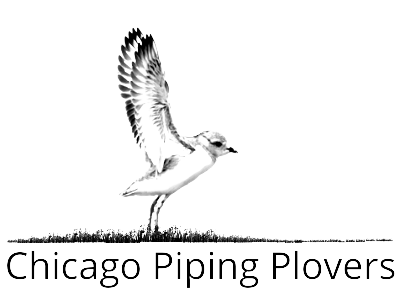Rare Great Lakes Piping Plovers at Montrose Beach
Monty and Rose Exchanging nesting duties, 2019 - Photo by Tamima Itani
Why Is This Special?
In June, 2019, a pair of Great Lakes Piping Plovers began nesting at the Montrose public beach. It was the first instance of Piping Plover nesting in Chicago and Cook County in 71 years (since 1948) and an exciting development for this federally endangered species
Nearly extinct from the Great Lakes region, the pair represented one of approximately 70 Great Lakes Piping Plovers. This was a major milestone in their recovery from a low of just 13 pairs in the early 1980's, when they were declared federally endangered.
The pair - nicknamed Monty and Rose- returned and nested in 2020 and 2021. Sadly, both passed away in 2022. However, their son Imani who hatched at Montrose in 2021 has been returning annually since, and we hope that a female will come to Montrose and nest with him during the breeding season.
As one of only 70 pairs, the 2 Piping Plovers at Montrose Beach were an an extremely rare treat, and so is there son Imani and all visiting Piping Plovers! It’s important to provide them with the space they need to rest, feed, survive, reproduce, nest and raise their young chicks at this special Chicago site.
Adult with chick, 2019, photo by Tamima Itani
How Do We Protect Them?
Great Lakes Piping Plovers are an endangered species and are federally protected by the Endangered Species Act. The U.S. Fish and Wildlife Service (USFWS) administers the Endangered Species Act, and protects the Montrose Plovers, in collaboration with the Illinois Department of Natural Resources (IDNR), the Chicago Park District (CPD), and volunteers from Chicago Ornithological Society, Chicago Audubon Society, and Illinois Ornithological Society.
Ahead of the breeding season and for the duration of Piping Plover presence at Montrose, the Chicago Park District, working with the USFWS and IDNR ropes off the natural areas at Montrose. When a nest is confirmed, a cage is placed around the nest to protect the eggs from predators and other dangers. The Piping Plover parents can freely move in and out of the protective cage, and they take turns sitting on the nest or feeding. The nest typically has four eggs.
Piping Plovers share Montrose Beach with the many other birds who use it year round, for nesting and breeding in the summer, and/or as an important stopping off point during Spring and Fall migrations for rest and feeding.
What Can You Do To Protect Them?
Share the Shore. Shorebirds need to rest and feed uninterrupted if they are to survive and breed.
If you see a Piping Plover of shorebird on the beach, keep as much distance as possible between you and them. Try to not interrupt their feeding or their rest. Do not chase them.
Make sure to collect all your belongings when you leave the beach. Do not leave trash on the beach.
When fishing, make sure you collect all fishing line and properly dispose of it. Do not leave fishing line in the water or on the beach. If you have a dog, take advantage of the Montrose dog beach.
Dogs, whether on leash or off leash, are not allowed at the Montrose public beach or on the protected beach in the natural areas.
About Plovers
Piping Plovers typically lay 4 eggs, which hatch in about 30 days. Chicks can walk and feed soon after hatching but rely on their parents for protection and warmth. After about 30 days, chicks can fly.
Great Lakes Piping Plovers (GLPIPLs) are small, slightly larger than a sparrow, but smaller than a robin.
GLPIPLs have bands on their legs for identification.
GLPIPLs eat insects, spiders, and other small invertebrates.
They migrate to warmer areas in late summer and fall (such as Florida and Texas).



